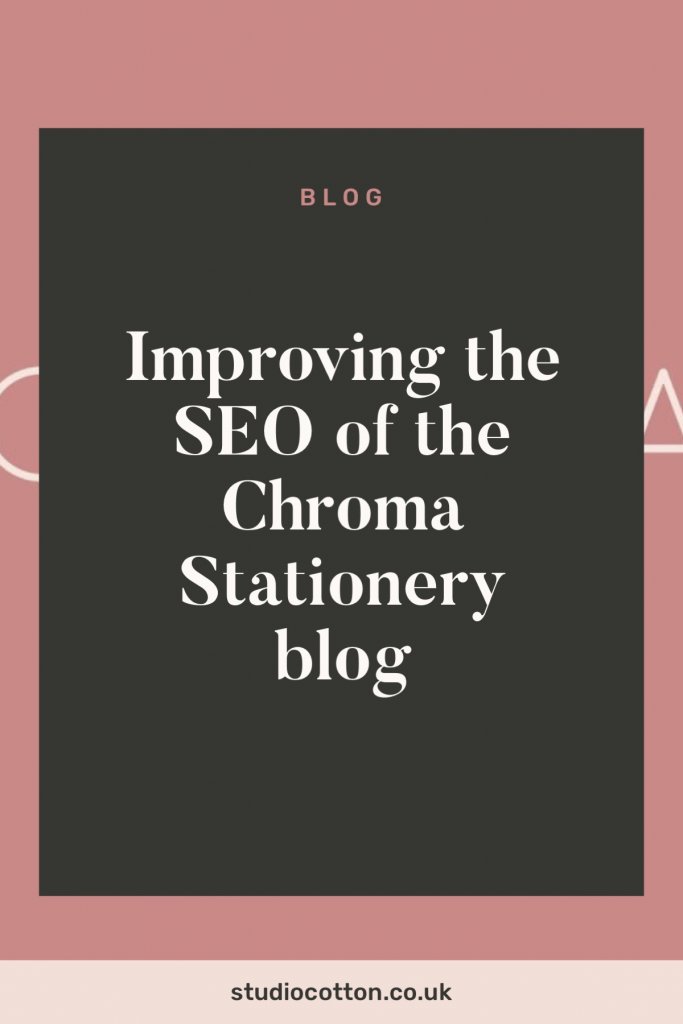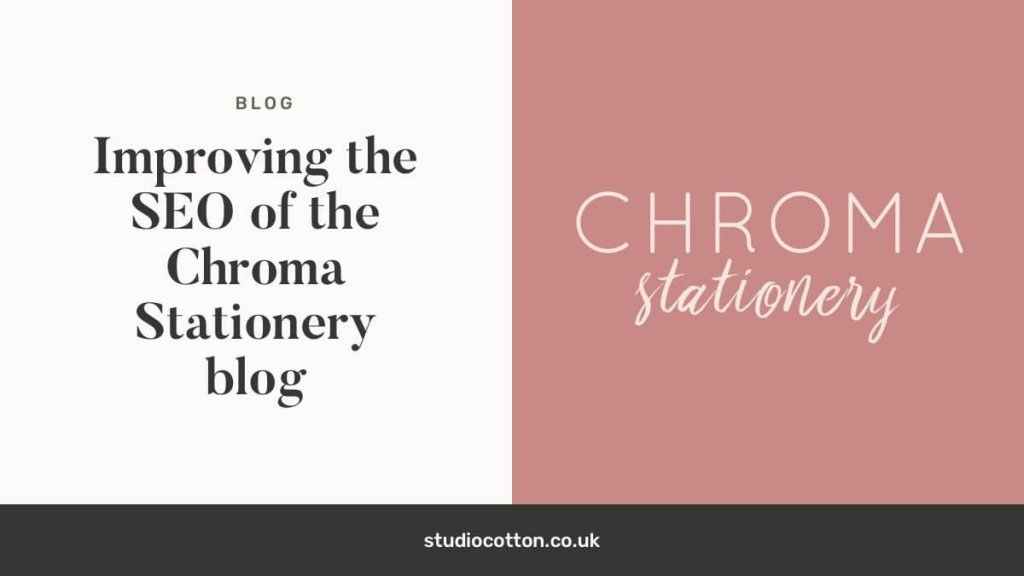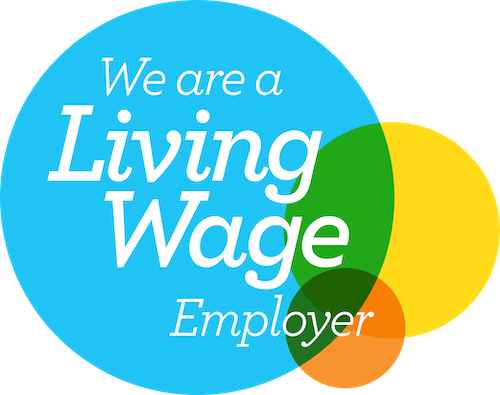
What a great way to kick off our new Ask Aime Anything feature. I love discussing search engine optimisation or SEO, so our first question from Chroma Stationery founder Gabi Cox (no relation – I think!) couldn’t really be more perfect. So how can Gabi improve the SEO of her brand blog for Chroma Stationery?
We’ve turned this article into a two parter as it just got a little insane! So when you’re done, check out part two where we analyse a specific Chroma Stationery blog post.
1. Let’s totally forget about search engines.
And here’s why. Search engines like Google are working for the searcher, not for you the website owner. All Google and the alternatives want to do is provide the best answer to a searcher’s question, or the best solution to a searcher’s problem.
The real challenge for SEO is making sure that your website and your blog provides the best possible answers and solutions for your dream customer, the person searching.
Chroma Stationery feels a little bit special here as the brand operates in both the business-to-business (B2B) and business-to-consumer (B2C) marketplaces – so I asked Gabi to describe the Chroma Stationery dream client:
- Individual website customers: female, 17-35, repeat purchaser who shops for herself and gifts.
- Brands: Creative industries which value personalisation and have budget to spend. Repeat purchases for events, workshops, etc.
I’m about to blow your mind. There’s still only one target audience for Chroma Stationery. It’s an oversight that B2B brands often make – turning their target audience into faceless corporations. In fact the relationship is held between Gabi and the brand buyers – who in reality are the exact same 17-35 year-old women who shop for themselves and buy lots of gifts.
By putting a personal description of a buyer to a brand it’s a heck of a lot easier to market in the B2B sphere too. You can be more creative, more playful and direct by still appealing to a human person with the ability to fall in love with your brand.
Anyway, I’m going a bit off track so let’s turn this back to blogging and SEO.
2. Define the answers and solutions, and create a list of blog subjects from this
Chroma Stationery sells personalised colourful stationery. Having such a defined product is a total SEO boon as it means Gabi can create truly targeted content. That is like totally baller.
Here are a few questions & answers and problems & solutions that I’ve put together for this blog post, the list is by no means exhaustive.
Question: Where can I buy personalised stationery?
Answer: You can buy personalised stationery from Chroma Stationery
Problem: I need to buy a present for my friend who loves stationery
Solution: Buy a beautiful personalised notebook from Chroma Stationery
Question: Where can I bulk buy personalised stationery?
Answer: You can bulk buy personalised stationery from Chroma Stationery
Problem: I need custom notepads to give away at an exhibition
Answer: Chroma Stationery creates and prints personalised notebooks for businesses of all sizes.
Just from this short list, I’ve popped together a list of blog post subjects that would appeal to the target audience – just by aligning with the topics they’re already searching for:
- Our 5 favourite personalised notebooks for Valentine’s Day
- 5 alternative gifts for stationery addicts (with bonus personalisation!)
- Buying in bulk: The new marketers guide to working with a stationery supplier
- How to design the best stationery for exhibition giveaways
The ‘5’ can be replaces with any number, I just like to start with 5 as it’s a pretty sexy number. Dem curves.
3. The same question and problems can have multiple answers and solutions
There’s usually more than one way to solve a problem, and often multiple answers to the same question – unless it’s fake news of course. This is great for brand blog owners for a couple of reasons, it provides you multiple prompts to create blog content and covers all bases for different search terms.
So I’m going to expand on the following:
Question: Where can I buy personalised stationery?
Answer: You can buy personalised stationery from Chroma Stationery
We already have one way of providing an answer to that question:
- Our 5 favourite personalised notebooks for Valentine’s Day
…I think you can see where this is going. Blog subjects can be tweaked slightly to open up more opportunities to create high-quality, targeted content that is interesting too. We can already switch up the above to create 5 more valuable and interesting blog subjects:
- Our 5 favourite personalised notebooks for Mother’s Day
- Chroma Stationery’s 5 favourite personalised notebooks for Christmas
- Gabi’s 5 favourite personalised year planners for 2019
- Our 5 favourite personalised diaries for stationery lovers this Christmas
- Our 5 favourite planners to help you get organised this Spring – and they’re personalised too!
We can even do this with some of the more obscure blog posts, making them even more targeted. Again, this is really incredible for website owners when it comes to SEO, you’ll be writing totally original content (something Google loves) about a unique subject (hey, Google loves that too) that’s timely too (the Google dream!).
For example:
- How to design the best stationery for exhibition giveaways
Can be:
- Trend alert: Essential exhibition stationery for Spirit of Summer 2019
- Florals, botanicals and script fonts: Stationery trends for Top Drawer 2019 giveaways
Now that is some sexy sexy content. What’s even better is that every single one of these posts can be written well in advance, taking all the stress away.
4. How to communicate your answers and solutions
The subject of a blog post is by far the important factor when it comes to attracting the searchers you want to your blog. Once you’ve got that perfect subject and a steady flow of great content – you are almost golden.
Now we need to properly focus on how search engines like Google work. We know we have the right answers and right solutions, now we just need to present them in a way that is just so so so so so so so damn easy for Google to read and understand.
SEO keywords for brand bloggers
I’ve written quite a bit about key words in the past, like my article on how to pick and use your brand keywords. So here’s a take on the subject that’s a little different.
Keywords are simply the terms that you know your website should rank for when searched on Google. A defined list of keywords just allows you to focus efforts and give yourself another tool for making sure you’ve included all the right information.
As well as the method I’ve described in my other blog post, we can take our keywords directly from our questions, answers, problems and solutions:
Question: Where can I buy personalised stationery?
Answer: You can buy personalised stationery from Chroma Stationery
Problem: I need to buy a present for my friend who loves stationery
Solution: Buy a beautiful personalised notebook from Chroma Stationery
Question: Where can I bulk buy personalised stationery?
Answer: You can bulk buy personalised stationery from Chroma Stationery
Problem: I need custom notepads to give away at an exhibition
Answer: Chroma Stationery creates and prints personalised notebooks for businesses of all sizes.
Once you have your list of keywords, you should be throwing that pish on everything. By doing so, Google can see super clearly that your blog post contains the most thorough answers and solutions.
Content hierarchy and missed SEO opportunities
In order to work with search engines, we need to read our websites like they do. As well as the words on the page, Google reads the structure too. Google knows that page titles are more important than pull quotes, that body copy is more important than social links, and that headings are (you guessed it) more important than subheadings.
There’s also plenty of areas for giving Google more help which we all overlook – image names, alt-tags and captions are all opportunities to include keywords and context that will only help your SEO.
It’s important to analyse every blog post from a robotic perspective. Make sure your blog post title is a fair reflection of the contents and includes the most important information. Check that your headings and subheadings properly describe the text that follows. And complete your gosh dang image data.
Loving the SEO theory from this article? Check out part two Improving the SEO of the Chroma Stationery blog for how we’ve applied this theory and more to a specific blog article from Chroma Stationery.
























